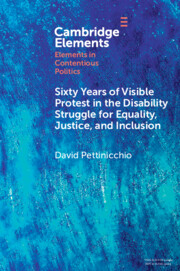Element contents
Sixty Years of Visible Protest in the Disability Struggle for Equality, Justice, and Inclusion
Published online by Cambridge University Press: 16 March 2024
Summary
- Type
- Element
- Information
- Series: Elements in Contentious PoliticsOnline ISBN: 9781009497893Publisher: Cambridge University PressPrint publication: 11 April 2024



